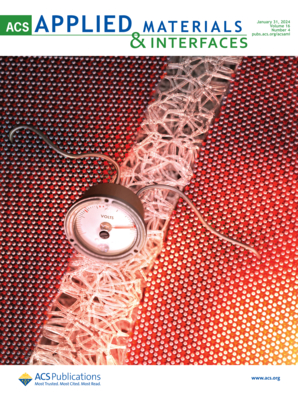胰泌素通过卡贾尔间质细胞和 cAMP 机制抑制小肠蠕动
IF 8.3
2区 材料科学
Q1 MATERIALS SCIENCE, MULTIDISCIPLINARY
引用次数: 0
摘要
背景:胰泌素是胰泌素-胰高血糖素-活性肠肽激素超家族的成员,是一种多功能胃肠道(GI)和神经肽激素。胰泌素主要在餐后从十二指肠肠内分泌 S 细胞的利伯昆隐窝分泌到血液循环中,并到达中枢神经系统和外周的胰泌素受体靶点。这种动态激素已被证明是调节消化、新陈代谢和能量消耗、水潴留、繁殖、脂肪组织产热以及胃肠蠕动的关键信号分子。胰泌素在消化道中的典型作用是刺激胰腺管和胆管分泌碳酸氢盐和胆汁,以中和胃中的酸性食糜。胰泌素还被证明能减缓肠道蠕动,但其作用靶点和机制尚不清楚。目的:一些研究提出,胰泌素主要通过存在于胃肠道迷走神经传入上的许多胰泌素受体来减缓肠道内的肠蠕动,我们在此讨论的新数据表明,通过卡贾尔间质细胞(ICC)存在另一种互补的信号途径。卡贾尔间质细胞起着联络作用,通过激活泌乳素受体(SCTR)和随后刺激第二信使环磷酸腺苷(cAMP),促进消化道平滑肌收缩力的降低。在此,我们提供证据说明 ICC 如何介导小肠肌原活动和运动的变化。研究方法使用旋转盘共焦点显微镜监测 GCaMP6f x KitiCre 小鼠小肠肌肉 ICC 中的 Ca2+ 信号传导。此外,还利用 CAMPER 小鼠评估了 cAMP 水平。使用肌条肌电图实验评估了肠道肌肉的收缩能力。结果在河豚毒素(TTX)作用下,胰泌素可降低小肠收缩力,并抑制胆碱能传递的效应。胰泌素受体(SCTR)主要在ICC上表达,特别是在小肠深层肌肉丛(ICC-DMP)内的ICC上,Ca2+成像证实其作用主要在ICC-DMP内。在 LNNA(NO 合酶抑制剂)和 MRS2500(P2Y1 拮抗剂)的作用下,胰泌素可减少卡巴胆碱诱导的收缩和 ICC-DMP 在电场刺激(EFS)下的 Ca2+ 瞬态。胰泌素会导致 Kit-iCre-CAMPER 小鼠肌肉中 ICC-DMP 的 cAMP 水平升高。PKA 抑制剂可缓解胰泌素对 ICC-DMP Ca2+ 信号转导的部分影响。对完整大肠节段(4-5 厘米)直径变化的测量显示,小鼠对分泌素的反应明显减弱。结论:胰泌素可通过 cAMP 介导的机制激活 ICC-DMP 上的 SCTR,从而抑制小肠运动。这些结果表明了 ICC 上的新型分泌素靶点是如何影响消化道肌肉并减少推进和节段运动以促进餐后营养吸收和消化的。资助:本项目由美国国家糖尿病、消化系统和肾脏研究所(NIDDK)的 R01 DK-120759 支持。本文是在 2024 年美国生理学峰会上发表的摘要全文,仅提供 HTML 格式。本摘要没有附加版本或附加内容。生理学》未参与同行评审过程。本文章由计算机程序翻译,如有差异,请以英文原文为准。
Secretin Inhibits Small Intestinal Motility via Interstitial Cells of Cajal and cAMP Mechanisms
Background: Secretin is a member of the secretin-glucagon-vasoactive intestinal peptide hormone superfamily and is a multifunctional gastrointestinal- (GI) and neuro- peptide hormone. Secretin is primarily secreted postprandially from the crypts of Lieberkühn of duodenal enteroendocrine S cells into circulation where it reaches secretin receptor targets in the central nervous system and periphery. This dynamic hormone has been shown to act as a key signaling molecule in the regulation of digestion, metabolism and energy expenditure, water retention, reproduction, thermogenesis in adipose tissue, and in gastric and intestinal motility. Secretin’s canonical role in the GI tract is to stimulate the secretion of bicarbonate and bile from pancreatic ducts and bile ducts to neutralize acidic chyme exiting the stomach. Secretin has also been shown to slow intestinal motility, but its targets and mechanism of action is poorly understood. Aims: Several studies have proposed that secretin acts to slow intestinal motility in the intestines primarily through the many secretin receptors present on vagal afferents in the GI tract, here we discuss new data that suggests an alternate and complementary signaling pathway via interstitial cells of Cajal (ICC). ICC act as a liaison to facilitate a reduction in force of GI smooth muscle contraction through the activation of the secretin receptor (SCTR) and subsequent stimulation of the second messenger, cyclic adenosine monophosphate (cAMP). Here we provide evidence to show how ICC mediates changes in myogenic activity and motility in the small intestine. Methods: Spinning-disk confocal microscopy was used to monitor Ca2+ signaling in ICC from small intestinal muscles of GCaMP6f x KitiCre mice. Additionally, cAMP levels were evaluated using CAMPER mice. Intestinal muscle contractility was assessed using muscle strip myography experiments. Results: Secretin reduced small intestinal force of contraction in the presence of tetrodotoxin (TTX) and dampened the effect of cholinergic transmission. The secretin receptor (SCTR) is expressed primarily on ICC, specifically ICC within the deep muscular plexus (ICC-DMP) in the small intestine and Ca2+ imaging confirmed the effects are primarily localized within ICC-DMP. Secretin reduced carbachol-induced contractions and Ca2+ transients in ICC-DMP in response to electrical field stimulation (EFS) in the presence of LNNA (NO synthase inhibitor) and MRS2500 (P2Y1 antagonist). Secretin caused an increase in cAMP levels in ICC-DMP in muscles from Kit-iCre-CAMPER mice. PKA inhibitors rescued some of the effects of secretin on ICC-DMP Ca2+ signaling. Measurements of diameter change in large, intact, intestinal segments (4-5 cm) showed a significant decrease in response to Secretin. Conclusions: Secretin can inhibit small intestinal motility through the activation SCTRs on ICC-DMP via cAMP-mediated mechanisms. These results show how novel secretin targets on ICC influence GI muscles and reduce propulsive and segmental motility to facilitate nutrient absorption and digestion after a meal. Funding: This project was supported by R01 DK-120759 from the National Institute of Diabetes and digestive and Kidney (NIDDK). This is the full abstract presented at the American Physiology Summit 2024 meeting and is only available in HTML format. There are no additional versions or additional content available for this abstract. Physiology was not involved in the peer review process.
求助全文
通过发布文献求助,成功后即可免费获取论文全文。
去求助
来源期刊

ACS Applied Materials & Interfaces
工程技术-材料科学:综合
CiteScore
16.00
自引率
6.30%
发文量
4978
审稿时长
1.8 months
期刊介绍:
ACS Applied Materials & Interfaces is a leading interdisciplinary journal that brings together chemists, engineers, physicists, and biologists to explore the development and utilization of newly-discovered materials and interfacial processes for specific applications. Our journal has experienced remarkable growth since its establishment in 2009, both in terms of the number of articles published and the impact of the research showcased. We are proud to foster a truly global community, with the majority of published articles originating from outside the United States, reflecting the rapid growth of applied research worldwide.
 求助内容:
求助内容: 应助结果提醒方式:
应助结果提醒方式:


